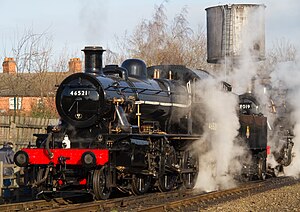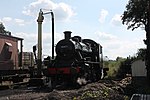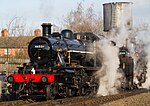LMS Ivatt Class 2 2-6-0
| LMS Ivatt Class 2 2-6-0 | |||||||||||||||||||||||||||||||||||||||||||||||
|---|---|---|---|---|---|---|---|---|---|---|---|---|---|---|---|---|---|---|---|---|---|---|---|---|---|---|---|---|---|---|---|---|---|---|---|---|---|---|---|---|---|---|---|---|---|---|---|
 46521 Ivatt class at Loughborough railway station, 28 January 2012. Photo by Tony Hisgett. | |||||||||||||||||||||||||||||||||||||||||||||||
| |||||||||||||||||||||||||||||||||||||||||||||||
| |||||||||||||||||||||||||||||||||||||||||||||||
| |||||||||||||||||||||||||||||||||||||||||||||||
| |||||||||||||||||||||||||||||||||||||||||||||||
The London, Midland and Scottish Railway (LMS) Ivatt Class 2 2-6-0 is a class of steam locomotive designed for light mixed traffic.
Contents
1 Design
2 Construction
3 Preservation
4 Models
5 In fiction
6 References
7 External links
Design
Elderly 0-6-0s formed the backbone of the low-powered locomotives within the LMS fleet. William Stanier had concentrated on introducing larger engines and it was left to George Ivatt to introduce a new class of low-powered locomotive. He designed a tender version of the Ivatt Class 2 2-6-2T, introduced at the same time, which was inspired by the Stanier Class 3 2-6-2T, which was inspired by the Fowler Class 3 2-6-2T. The 2-6-0s had greater range: 3,000 imperial gallons or 14,000 litres or 3,600 US gallons of water and 4 long tons or 4.1 tonnes or 4.5 short tons of coal compared to the tank design's 1,350 imperial gallons or 6,100 litres or 1,620 US gallons and 3 long tons or 3.05 tonnes or 3.36 short tons. So they were well-suited to their task and, following attention to draughting problems by both Derby and Swindon, quickly became a success. Further engines of this type were built as the BR standard class 2 2-6-0, these locomotives having BR standard fittings and a modified cab and tender profile to allow completely unrestricted route availability; both LMS and BR 2MT moguls are often nicknamed "Mickey Mouse".[1]
Construction
A total of 128 were built between 1946 and 1953, mostly at Crewe. 20 were built by LMS and given the numbers 6400–19. On nationalisation in 1948 40000 was added to their numbers to become 46400–19. The remaining 108 locomotives of the class, numbered 46420–46527 were built by British Railways, and from 46465 (Darlington, 1951) an increase in cylinder diameter of 1⁄2 inch (13 mm) yielded a tractive effort of 18,510 lb (8,400 kg), 1,100 lb (500 kg) greater than the original design. The LMS classified them 2F, BR as 2MT.
| Number | Lot no. | Date | Built at | |
|---|---|---|---|---|
| LMS | BR | |||
| 6400–09 | 46400–09 | 182 | 1946 | Crewe |
| 6410–19 | 46410–19 | 189 | 1947 | Crewe |
| — | 46420–34 | 194 | 1948 | Crewe |
| — | 46435–49 | 201 | 1950 | Crewe |
| — | 46450–59 | 207 | 1950 | Crewe |
| — | 46460–64 | 208 | 1950 | Crewe |
| — | 46465–82 | 1309 | 1951 | Darlington |
| — | 46483–94 | 1310 | 1951 | Darlington |
| — | 46495–502 | 1310 | 1952 | Darlington |
| — | 46503–14 | 394 | 1952 | Swindon |
| — | 46515–27 | 394 | 1953 | Swindon |
The 38 members of the Darlington-built batch (46465 to 46502) were allocated to the Eastern and North Eastern Regions of British Railways. The final 25 (46503 to 46527) were built at Swindon Works and, being allocated to the Western Region, consequently carried the GWR-type vacuum ejector and firehole doors. The Swindon locomotives were turned out, initially, in lined black. Under the Hanks regime, some received lined green livery as they passed through works. The rest carried black livery. None of the class was named in service, however some have been named in preservation.
The class was withdrawn between 1961 and 1967.
| Year | Quantity in service at start of year | Quantity withdrawn | Locomotive numbers |
|---|---|---|---|
| 1961 | 128 | 1 | 46407. |
| 1962 | 127 | 12 | 46408/15/53/66/69/71/76–78/81/93/95. |
| 1963 | 115 | 4 | 46438/73/83/89. |
| 1964 | 111 | 8 | 46403/09/35/61/67/74/75, 46525. |
| 1965 | 103 | 21 | 46404/13/20/23/25/30/44/56/59/68/72/79/82/88/97/98, 46510/11/24/27. |
| 1966 | 82 | 40 | 46401/05/10/12/14/16/19/21/22/24/26–29/34/42/45–47/50/51/54/58/60/62–64/95/96, 46504/08/09/12–14/17–19/21/26. |
| 1967 | 42 | 42 | 46400/02/06/11/17/18/31–33/36/37/39–41/43/48/49/52/55/57/65/70/80/84–87/90–92/99, 46500–03/05/06/15/16/20/22/23. |
Preservation
Seven of the class have been preserved but only six engines have run in preservation (46428 is undergoing restoration from scrapyard condition to working order at the East Lancs Railway). Three members of the class have also operated on the mainline in preservation: No's 46441, 46443 & 46521.
46443 Became a popular mainline engine in the 1980s when she was one of the engines used during the 150th anniversary of the Great Western Railway traveling along many old branchlines including the old Bristol Harbour Railway.
46521 Saw use on the mainline in the 1990s but only saw a limited amount of use hauling excursion trains with one of her runs being on the GWML in December 1994.[2]
46441 Was one of the smallest tender engines to operate on the former BR system during the 90's. As well as being a regular at Carnforth and working at her home on the East Lancashire Railway she was also used for the regular steam on the met programme working trains alongside other steam engines. 46441 Is currently located at the Ribble Steam Railway in Preston and is currently on static display inside the museum awaiting overhaul. The locos current owner Chris Beet who also owns LMS Jubilee no 45690 Leander currently has no plans in overhauling the loco.
| BR no | Image | Name* | Builder | Built | Withdrawn | Service Life | Current Location | Current Condition | Livery | Notes |
|---|---|---|---|---|---|---|---|---|---|---|
| 46428 |  | Crewe Works | Dec 1948 | Dec 1966 | 17 Years, 11 Months | East Lancashire Railway | Under Restoration | N/A | Being restored from condition as recovered from Woodham Brothers scrapyard, Barry, Vale of Glamorgan, South Wales. | |
| 46441 |  | Crewe Works | Feb 1950 | Apr 1967 | 17 Years, 2 Months | Lakeside and Haverthwaite Railway | Static Display | BR Lined Crimson, Late Crest | In non-authentic BR Maroon livery. | |
| 46443 |  | Crewe Works | Feb 1950 | Mar 1967 | 17 Years, 28 Days | Severn Valley Railway | Static Display | BR Lined Black, Late Crest | Stored awaiting overhaul in The Engine House, Highley. | |
| 46447 |  | Crewe Works | Mar 1950 | Dec 1966 | 16 Years, 9 Months | East Somerset Railway | Operational | BR Lined Black, Late Crest | Returned to operation October 2014. On loan from the Isle of Wight Steam Railway. | |
| 46464 |  | The Carmyllie Pilot | Crewe Works | Jun 1950 | Sept 1966 | 16 Years, 3 Months | Bridge of Dun | Under Restoration | N/A | After preservation, hauled the first scheduled passenger train on the Strathspey Railway on 22 July 1978.[3] Currently being restored to working order. The name "Carmyllie Pilot" was used, during their working years, for both 46463 and 46464, both Dundee Tay Bridge (62B) allocated engines. Both locomotives took week about pilot duties at Arbroath station, and were often seen working the Carmyllie Railway branch line, either to the Metal Box factory or the Quarries at Carmyllie (see Carmyllie Railway). Local railway staff referred to either locomotive as The Carmyllie Pilot, dependant on which was on duty. |
| 46512 |  | E.V. Cooper, Engineer | Swindon Works | Dec 1952 | Dec 1966 | 13 Years, 11 Months | Strathspey Railway | Operational | BR Lined Black, Early Emblem | Returned to operation March 2011. |
| 46521 |  | Blossom* | Swindon Works | Mar 1953 | Oct 1966 | 13 Years, 7 Months | Great Central Railway | Operational | BR Lined Green, Early Emblem | Returned to operation January 2012. |
* Named in preservation
Only 46428 has yet to steam in preservation.
Models
Several 00 gauge ready-to-run models of the locomotive have been produced. In 1975, Hornby Railways produced a model of the class, in British Railways lined black (mixed traffic) livery. A BR lined green version followed in 1978. They were on sale until 1982.[4] In 2007 Bachmann Branchline introduced a more detailed model, available in several liveries including LMS unlined black, BR lined black and BR lined Brunswick Green, the latter livery of which was used for a model of now preserved 46521. Graham Farish produces several of the same liveries in N gauge. Comet Models produce an all-metal kit.
In fiction
No. 46521 appeared in the sitcom Oh, Doctor Beeching! It was for this that it received the name 'Blossom'.[5]
Both 46443 and 46521 appeared in the 1976 Universal Pictures film The Seven-Per-Cent Solution. For this role both locomotives were heavily disguised to have a European flavour.[6]
Both "Oh, Doctor Beeching!" and "The Seven-Per-Cent Solution" were filmed on the Severn Valley Railway.[5][6]
In the 2008 film adaption of Why Didn't They Ask Evans?, an Ivatt engine can be seen pulling an express train.[citation needed]
References
^ Hopkins, Simon (November 2007). "Bridgnorth's stalwart 'Mickey Mouse' is focus of charter". Steam Railway. 343: 24..mw-parser-output cite.citationfont-style:inherit.mw-parser-output .citation qquotes:"""""""'""'".mw-parser-output .citation .cs1-lock-free abackground:url("//upload.wikimedia.org/wikipedia/commons/thumb/6/65/Lock-green.svg/9px-Lock-green.svg.png")no-repeat;background-position:right .1em center.mw-parser-output .citation .cs1-lock-limited a,.mw-parser-output .citation .cs1-lock-registration abackground:url("//upload.wikimedia.org/wikipedia/commons/thumb/d/d6/Lock-gray-alt-2.svg/9px-Lock-gray-alt-2.svg.png")no-repeat;background-position:right .1em center.mw-parser-output .citation .cs1-lock-subscription abackground:url("//upload.wikimedia.org/wikipedia/commons/thumb/a/aa/Lock-red-alt-2.svg/9px-Lock-red-alt-2.svg.png")no-repeat;background-position:right .1em center.mw-parser-output .cs1-subscription,.mw-parser-output .cs1-registrationcolor:#555.mw-parser-output .cs1-subscription span,.mw-parser-output .cs1-registration spanborder-bottom:1px dotted;cursor:help.mw-parser-output .cs1-ws-icon abackground:url("//upload.wikimedia.org/wikipedia/commons/thumb/4/4c/Wikisource-logo.svg/12px-Wikisource-logo.svg.png")no-repeat;background-position:right .1em center.mw-parser-output code.cs1-codecolor:inherit;background:inherit;border:inherit;padding:inherit.mw-parser-output .cs1-hidden-errordisplay:none;font-size:100%.mw-parser-output .cs1-visible-errorfont-size:100%.mw-parser-output .cs1-maintdisplay:none;color:#33aa33;margin-left:0.3em.mw-parser-output .cs1-subscription,.mw-parser-output .cs1-registration,.mw-parser-output .cs1-formatfont-size:95%.mw-parser-output .cs1-kern-left,.mw-parser-output .cs1-kern-wl-leftpadding-left:0.2em.mw-parser-output .cs1-kern-right,.mw-parser-output .cs1-kern-wl-rightpadding-right:0.2em
^ [1]
^ 46464 Service in preservation
^ Hammond, Pat (2005). The Story of Rovex Vol 3 1972-1996. London: New Cavendish Books. pp. 166–7. ISBN 1 904562 00 0.
^ ab "Oh! Doctor Beeching Re-lives", Severn Valley Railway News issue 119, p. 33.
^ ab "A Film in the Making", Severn Valley Railway News issue 38, p. 5.
Rowledge, J.W.P. (1975). Engines of the LMS built 1923–51. Oxford: Oxford Publishing Company. ISBN 0-902888-59-5.
External links
| Wikimedia Commons has media related to LMS Ivatt Class 2 2-6-0. |
The Carmyllie Pilot Company Limited (owners of 46464)
